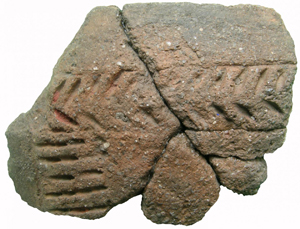Nature is publishing the article in which the UPV/EHU lecturers Alfonso Alday and the late Lydia Zapata participated
University of the Basque Country
Neolithic vessels from Atxoste (Alava, Spain). Credit: A. Alday (UPV/EHU)
The current loss of bee populations as a result of pesticides, viruses and parasites has increased awareness about their economic importance and essential role in farming societies. Our relationship with bees stretches way back before modern farming, which is shown, for example, in various depictions in Ancient Egypt or, going back even further, in the prehistory of the Iberian Peninsula, as in the famous panel in the Araña rock shelter in Bicorp, Valencia. But in actual fact, until now we have had no direct information as to when and where our interest in bees and their products came about. This is what this piece of work is about.
Given that beeswax is a unique lipid complex, its ‘biological footprint’, which is fairly degradation resistant, can be identified in the study of the organic residues preserved in archaeological sites. With this aim in mind, the international research team led by the School of Chemistry of the University of Bristol, analysed ceramic vessels of the Neolithic period in the Near East, Europe and North Africa. “Now we know that beeswax was used continuously from the seventh millennium BCE, probably as an integral part in different tools, in rituals, cosmetics, medicine, as a fuel or to make receptacles waterproof,” explained Alfonso Alday, lecturer in the Prehistory Area and, together with the late Lydia Zapata, a UPV/EHU participant in the research.
Farming emerged during the Neolithic era in various spots in the Middle East, and on occasions it had unexpected consequences: the opening up of forests to gain land and pastures encouraged the development of landscapes in which bushes and flowers provided environments suited to bees. In some way, the bees were the ‘pursuers of agriculture’, spreading their habitat as more farmland was being prepared.
The work on over 6,400 prehistoric vessels has specified the where and when of the first uses of beeswax. Now we know that the oldest evidence of it is to be found in Neolithic sites in Anatolia (Cayonü) in the seventh millennium BCE, in other words, corresponding to the oldest pottery cultures in the region. It is in this same area that the famous Çatalhöyük settlement is located and from which comes an ancient pictorial depiction of a bees’ nest. The use of beeswax has also been detected in prehistoric populations in the north-west of Anatolia; it has been dated between 5,500 and 5,000 years BCE often mixed with the fat of ruminants.
In Europe the first known finds are somewhat later: in Greece around 4900-4500, in Rumania from 5500-5200 onwards, and in Serbia in 5300-4600. We are aware of its use round about the same time in Central Europe in the Neolithic culture of Austria and Germany. More recent are the French and Slovenian cases. On the Iberian Peninsula the 130 receptacles analysed have not preserved any remains of wax, so it is necessary to conduct further research given than in Levantine art there are various depictions of bees: “You have to bear in mind the fact that the detection of signs of lipids of the wax inside the vessels is very low and that the number of receptacles analysed in Iberia is still very low,” but the logical thing is that the bees would also have found suitable environments to develop on the Iberian Peninsula since the beginnings of farming, in other words, about 5,500 years ago,” added Alday.
On the other hand, in this work we have shown that in Denmark and in the British Isles the use of bee products was earlier than expected, while the absence of evidence above parallel 57 on the Eurasian Steppe is probably indicating to us the ecological limit of bee colonies.
